Kia ora and welcome to the December 2020 update from the Transmission Gully team.
Tis the season for giving – so we have a bumper newsletter for you. A chance to reflect on the year that’s been and thank you for your continued interest in the project.
This time next year, the Transmission Gully motorway will be operating and people going away for the holidays will be able to plan on more reliable travel times on SH1 out of Wellington and onto the Kāpiti Coast.
But first, if you were one of the commuters caught up in traffic delays on SH1 near Paekākāriki recently we understand the frustration this created. We’re disappointed that the switch onto the new alignment didn’t go more smoothly, and that people experienced such long delays.
We did bed the new road surface in over a series of nights, but there is always some loose chip present for a period after chip seal is laid, which drivers naturally slowed down for. The new road layout, particularly southbound where SH1 merges from two lanes to one, also took a while to get used to. There are some things we could have done better – including clearer warnings to expect delays.
We explain more about why the traffic switch was necessary later on in this newsletter.
If you have any questions please contact us at info@tg.co.nz. If you have an urgent matter, please call the 24-hour project hotline on 0800 TGINFO. If we are working outside of our normal work hours and you’re one of our neighbours, we’ll be in touch with you directly as usual.
If you’ve driven on SH1 near Linden recently, you may have noticed the art panels that now adorn two retaining walls just south of where the Transmission Gully motorway will connect with the existing SH1. The Corten steel panels have been designed by Ngāti Toa artists, Nathan Te Rei, Ashleigh Sagar and Rākairoa Hori.
It may appear as if they popped up by magic, but our TG elves have been busy working overnights to get the installation complete with minimum disruption to traffic.
Find out how they did it, and what the design means below:
We’re so grateful to our Iwi partners Ngāti Toa for gifting names to some of the key structures on the road. The names reflect the area traversed by the Transmission Gully motorway. Ngāti Toa Rangatira kaumātua Tā Matiu Rei says the names gifted by the iwi were chosen to recognise many of the original place names that were changed during colonial settlement.
“We have been involved from the outset of the project and have, where possible, worked hard to influence decisions around cultural and environmental mitigation," Dr Taku Parai, board chair of Te Rūnanga o Toa Rangatira, says.
"All in all, it has been a successful working relationship with the project, and we are pleased to have another opportunity to assert our presence as mana whenua."
You can learn more about the names and the history behind them in the video below:
Without doubt this has been an extraordinarily challenging year for the Transmission Gully Project. Closing down a 27km construction site at short notice, maintaining site safety and environmental controls for five weeks, and then planning a staged site remobilisation under restricted workplace rules, is not something any of us could have prepared for.
Add to this the complexities of an international workforce, a disrupted nationwide supply chain, and a tightly programmed schedule of works, impacted by loss of the crucial pre-winter period – and we’ll all admit the operational issues were considerable.
But we’ve made great progress, despite the setbacks, and there’s a lot to celebrate.
Construction is now 88% complete, with 9.6 million work hours on the project to date.
Earthworks are now 98% complete, with over 10 million cubic metres of earth moved. It’s one of the largest volumes of earth to be moved on a New Zealand construction project.
While it is one of the shortest sections – just 800 metres of the 27 kilometres of new motorway, Pouāwha, the Wainui Saddle, is one of the most complex earthworks challenges in New Zealand due to the scale of the work, the steepness of the terrain, and the Ohariu fault line that runs right through the saddle.
Take a look at the approach to Pouāwha/ Wainui Saddle this time last year, compared to now.
Slope stabilisation works and batter chutes (drainage channels) in Pouāwha/ Wainui Saddle are 90% complete, with just 5,000 cubic metres of earthworks left to go before pavement works and roadside drainage can begin.
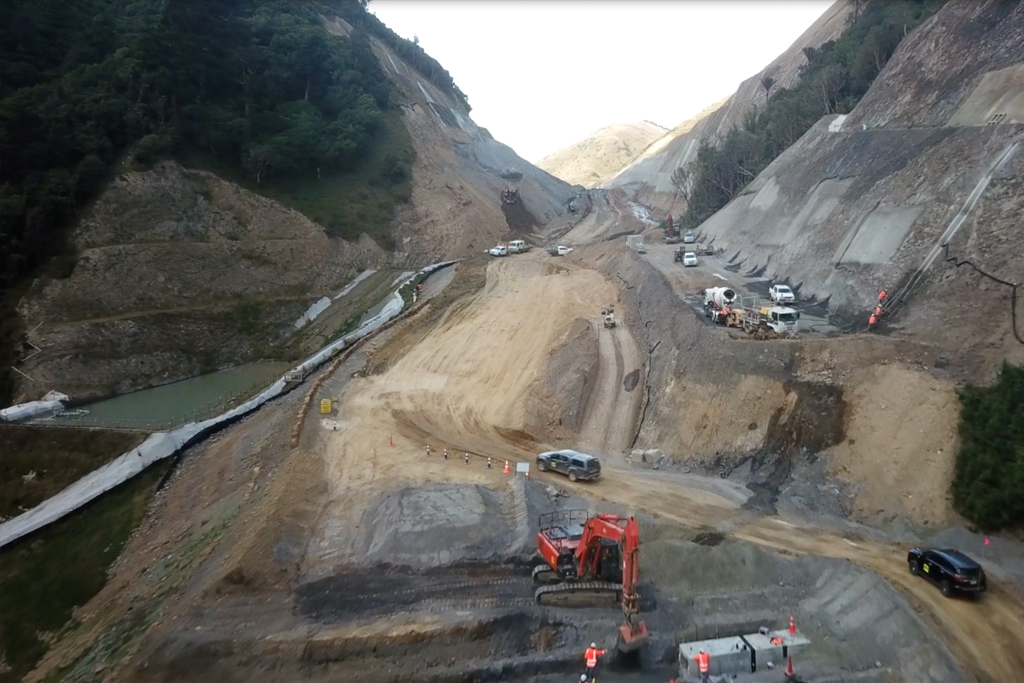
Northern approach to Wainui Saddle – December 2019.
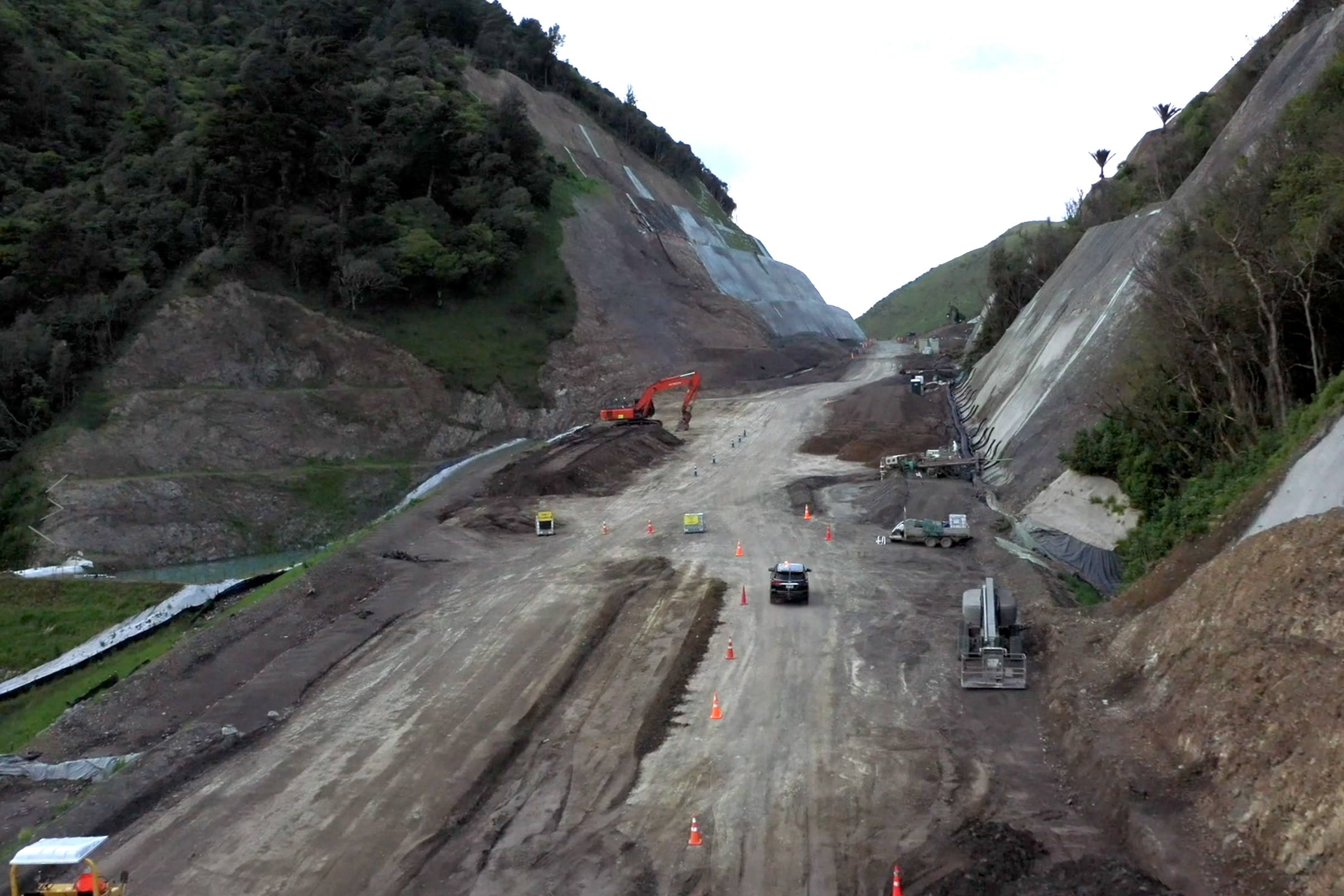
Northern approach to Wainui Saddle – December 2020.
From the air, it’s easy to see the progress made around the State Highway 58 interchange in the last 12 months.
The SH58 Interchange at Pāuatahanui will connect with existing SH58 routes to Paremata in the west and to the Hutt Valley in the east. We’ll be making further improvements to future-proof this interchange early next year.
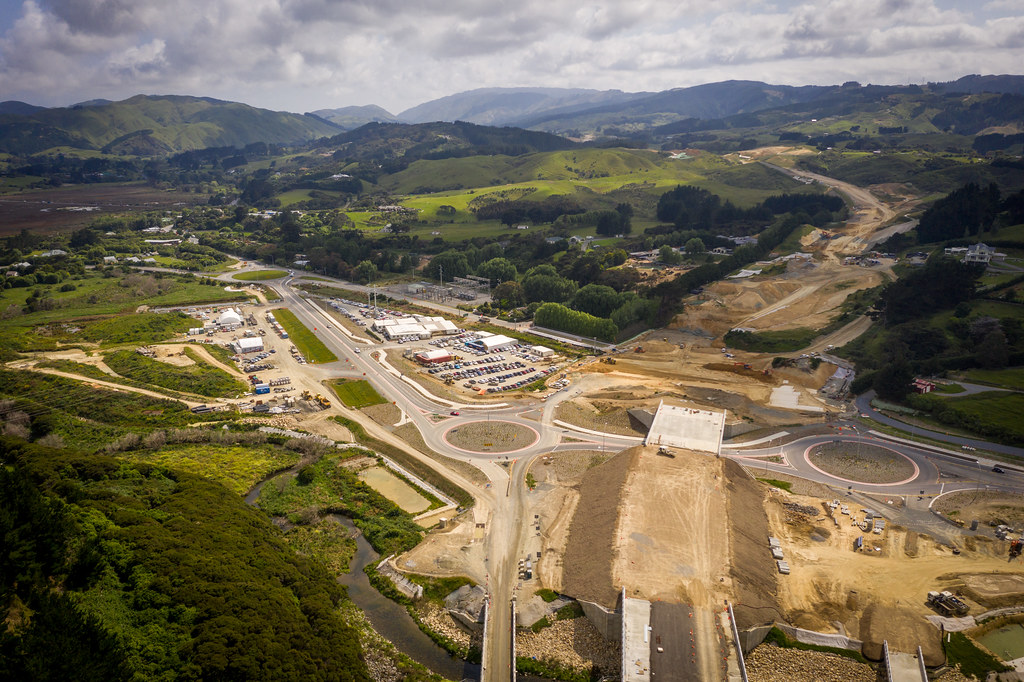
SH58 Interchange looking north – December 2019.
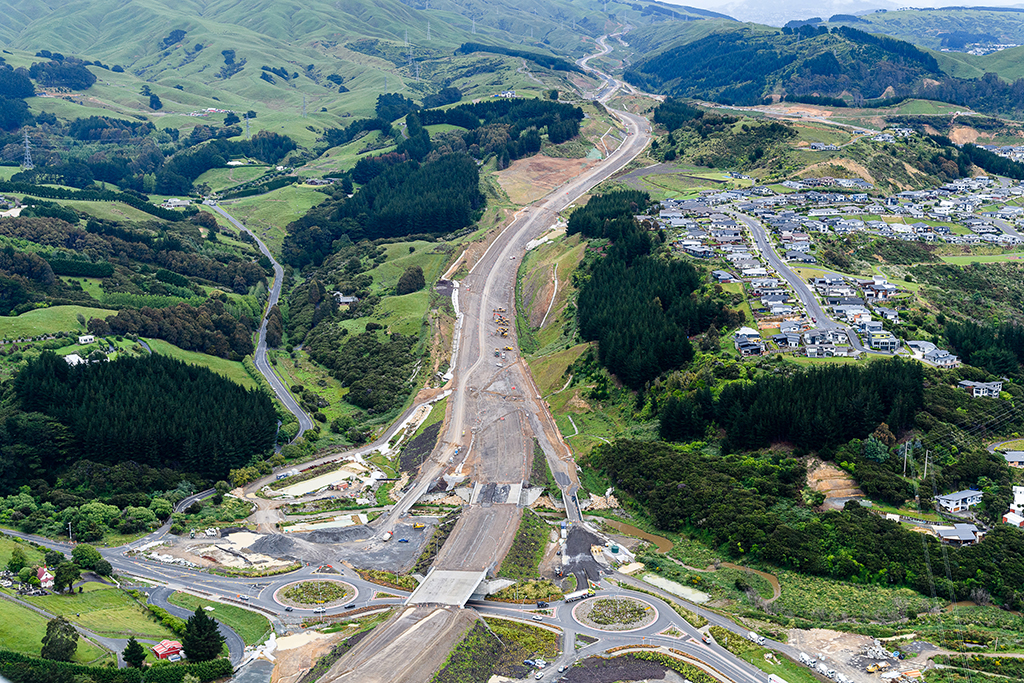
SH58 Interchange looking south – December 2020.
And of course the largest structure in the project, Te Ara a Toa (formerly known as bridge 20, or the bridge over Cannons Creek) has seen a lot of change this year too. The construction of Te Ara a Toa commenced in 2014 and was completed in late February 2020. The Wellington region is an area of high seismic activity, so designing and constructing a long, high, curving bridge that can withstand a one in 2500 year earthquake required innovative design, drawing on the skills and expertise of structural experts from around the world.
Congratulations to Napier-based Eastbridge Ltd for winning an excellence award in the ‘2020 Steel Construction NZ Excellence in Steel Awards’ for its work on steel support beams for the bridge.
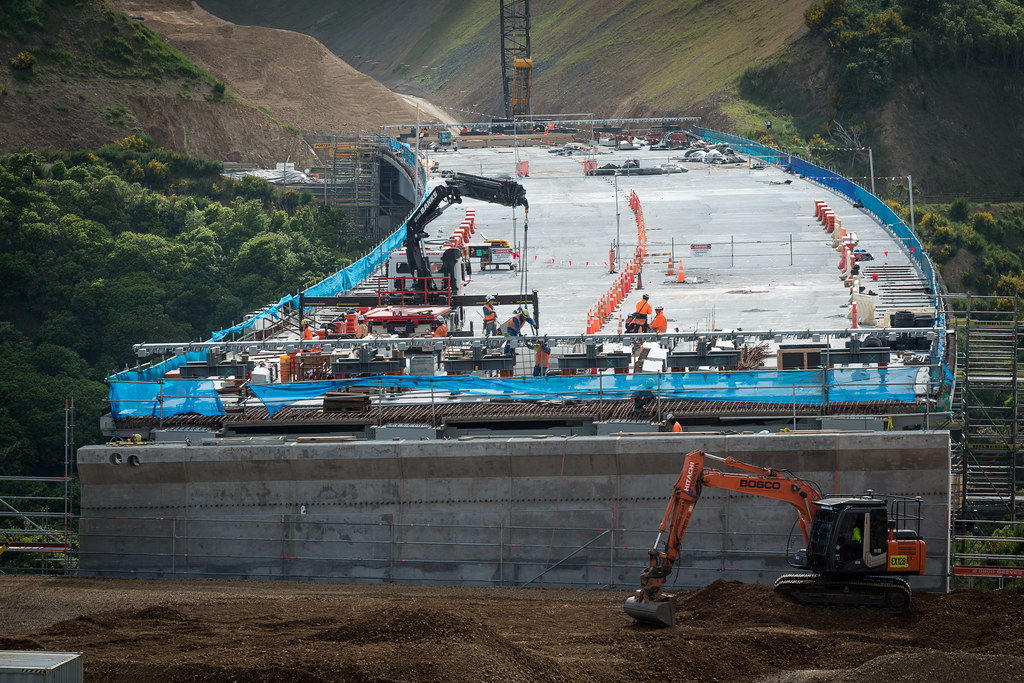
The southern end of Te Ara a Toa – 2019.
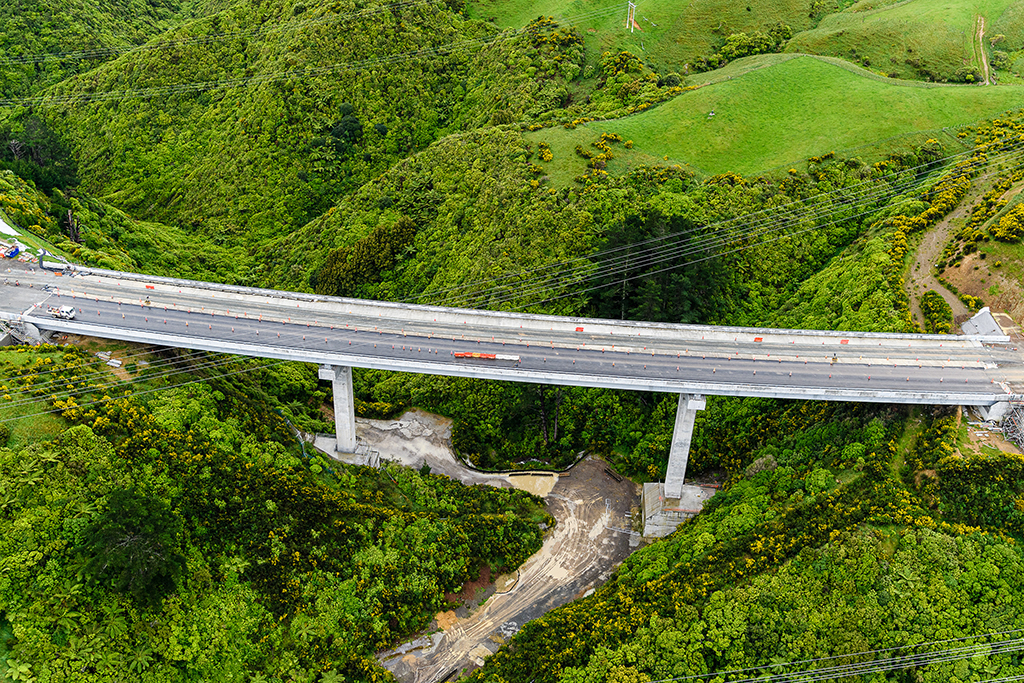
Te Ara a Toa – December 2020.
Our latest flythrough, filmed in November 2020, gives you a bird’s eye view of all our progress.
For comparison, check out the flythrough filmed in January 2020:
They say the kitchen is the heart of the home – for the next five months the heart of the northern end of Transmission Gully will be the temporary asphalt plant at Mackays crossing.
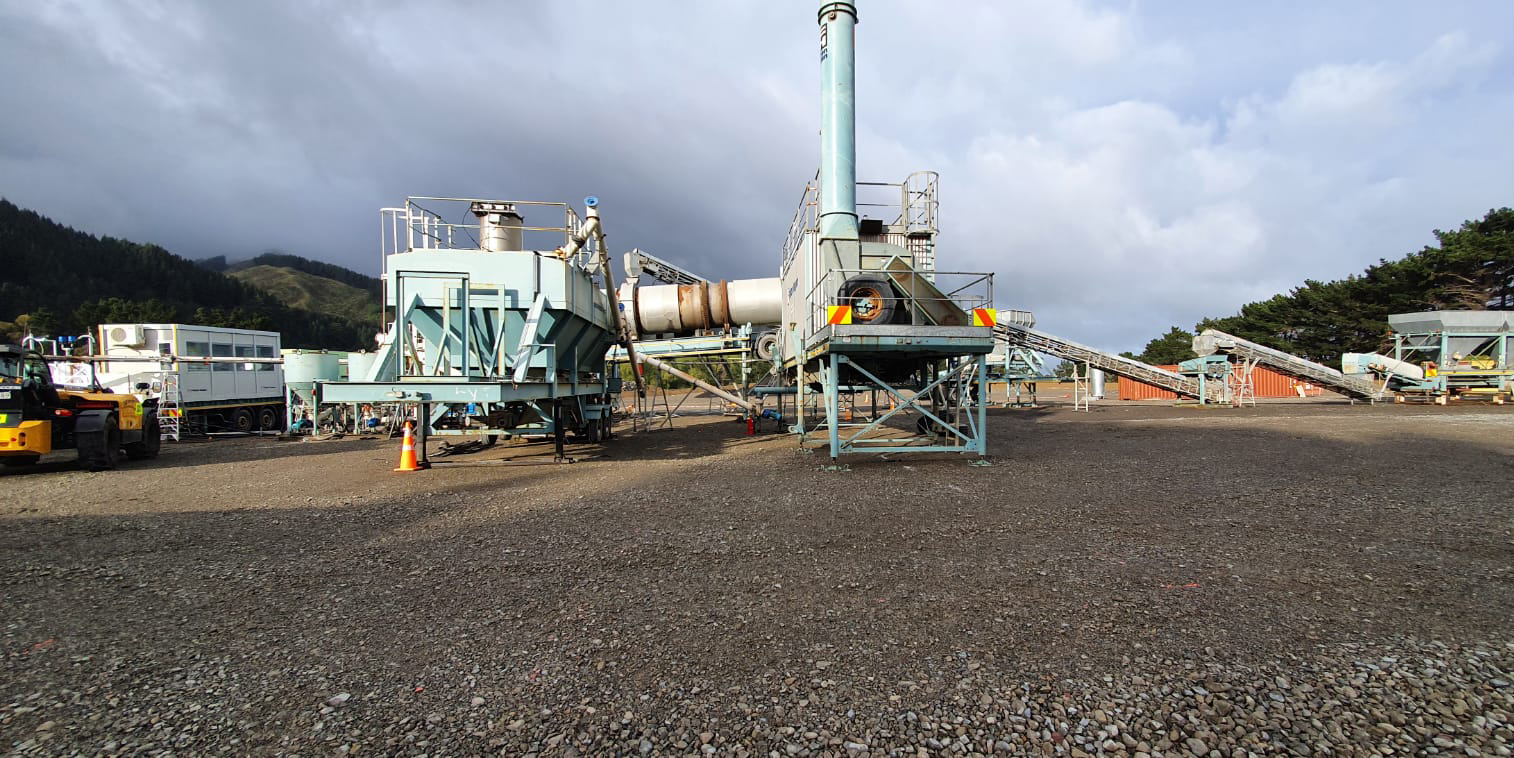
The temporary asphalt plant will be operated by Fulton Hogan. Once paving work is completed, the plant will be removed.
The plant is like a busy commercial kitchen cooking up the ‘Structural Asphalt’ (also known as ‘Deep Lift’) needed to finish the road.
First set the oven to 180 degrees, next combine your dry ingredients (a generous heap of fine and coarse aggregate) lastly add a chef’s pour of bitumen, then blend together and get cooking.
That’s how asphalt is made!
But in this case, there’s also a secret ingredient… a sprinkling of runway.
No, that is not a typo.
Our deep lift paving mixture will contain Recycled Asphalt Pavement (RAP) from Wellington Airport. Sand is a valuable resource, so old pavement from the airport has been carted to the Mackays asphalt plant where it will be crushed into finer aggregate-substituting sand and added to the recipe.
This is just one of the ways the project is meeting its sustainability goals and paving the way towards a green road for the future.
But that’s only the first step in the paving recipe. Timing is everything. Once it’s ready, the hot asphalt is poured into a truck and taken directly to where it’s needed on the alignment. Ideally, we don’t want it to lose more than 10 degrees on the trip – which is why it’s so critical to have the plant close to where it’s needed.
Once the truck arrives on site, the mixture is dumped into a paver (a type of machine which specialises in laying asphalt) and an eleven-person crew meticulously gets to work. There’s a supervisor, a paver driver, roller drivers and a quality control team. They’re checking the temperature and ensuring everything conforms to the correct quality controls.
It’s expert business, and it has to be. It costs around four hundred dollars per tonne to produce and lay asphalt.
If it gets too cold, or doesn’t meet quality checks, it may have to be ripped up and the whole process begins again.
Structural asphalt is a premium paving product. It can sustain high traffic volume, can be laid in more marginal weather conditions, and has a long life. It’s being used on the steeper parts of Transmission Gully, such as the approaches to Pouāwha/Wainui Saddle and on the busiest parts of the motorway, such as the interchanges.
It’s going to be hot in the kitchen. The asphalt plant, operated by subcontractor Fulton Hogan, will be working flat out to deliver 90 thousand tonnes of asphalt to the northern part of TG. At the southern end a different plant will be busy too, but it only has to deliver half that amount of asphalt.
Structural asphalt will be used to pave one third of the road, the rest will be surfaced with chip seal.
Chip seal is a highly resilient pavement and is the most commonly used type of road surface in New Zealand. It provides extremely good value and its qualities are highly suitable for the areas along the motorway in which it will be used.
Structural asphalt is much more resilient to poor weather during construction, meaning that work can continue to be carried out during marginal weather conditions, making up for time lost due to Covid 19.
It’s just one of the ways we’re ensuring the motorway is ready to open in September 2021.
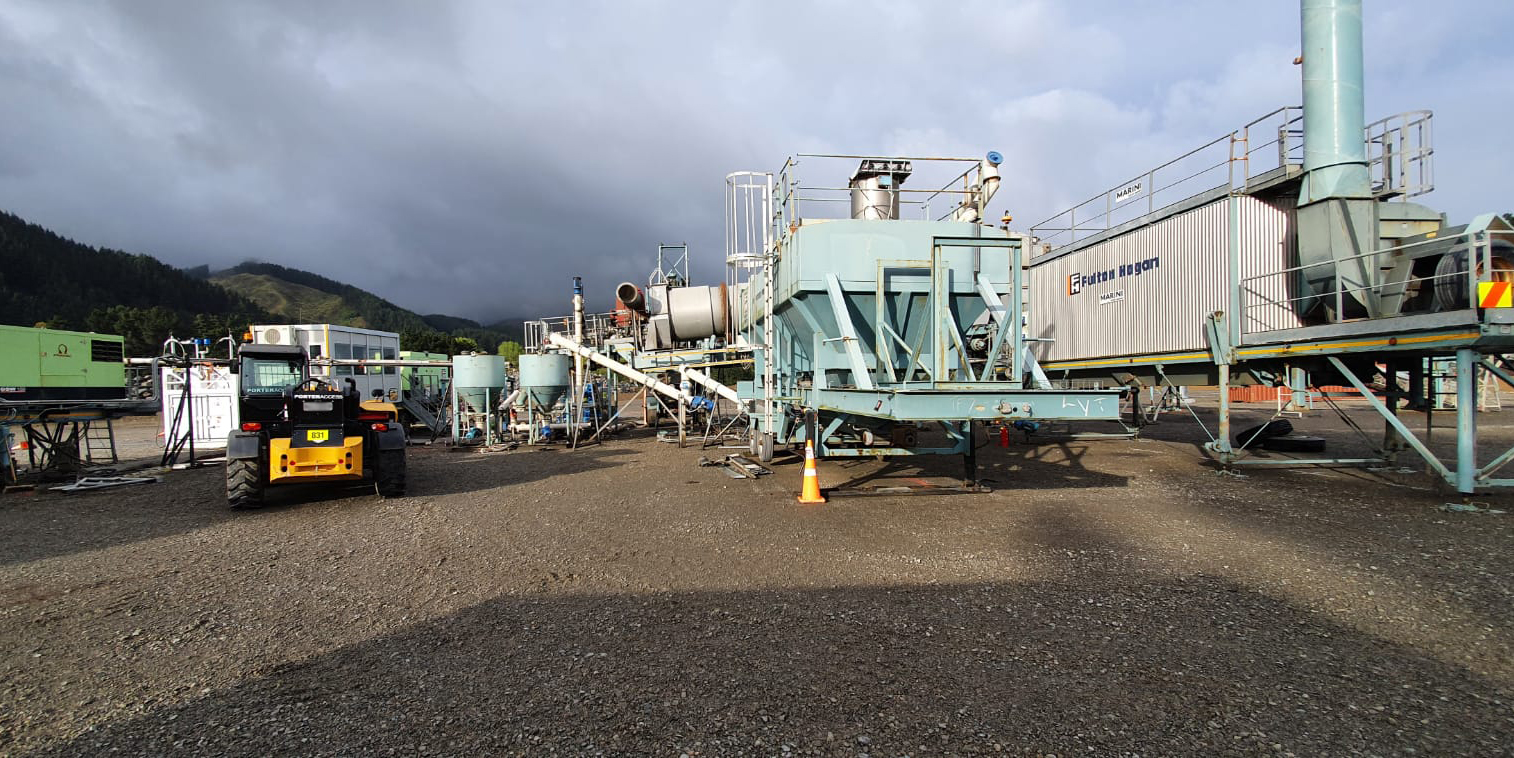
The temporary asphalt plant will be operational from mid-December. Final checks are underway before truck deliveries commence.
As we mentioned earlier, we’re disappointed that the switch onto the new alignment didn’t go more smoothly, and that people experienced such long delays.
The push to get Transmission Gully paved over the summer months is one of the reasons why we needed to get traffic switched onto the new section now.
It was required to allow the safe operation of the temporary asphalt plant, which will see an increase in truck movements carrying the structural asphalt to the northern end of the project.
The new road layout will separate asphalt trucks and other site vehicles from State Highway traffic.
The switch also allows us to complete work on the parallel road, which will connect traffic between the Paekākāriki and Mackays crossing interchanges.
We had hoped this switch would occur several weeks earlier but the wet weather in October and November delayed work on the new road.
We are pleased that traffic is now flowing better as drivers are becoming accustomed to the new road layout and the surface is settling down. It is safe to travel at the posted speed limit, but please remember to merge like a zip.
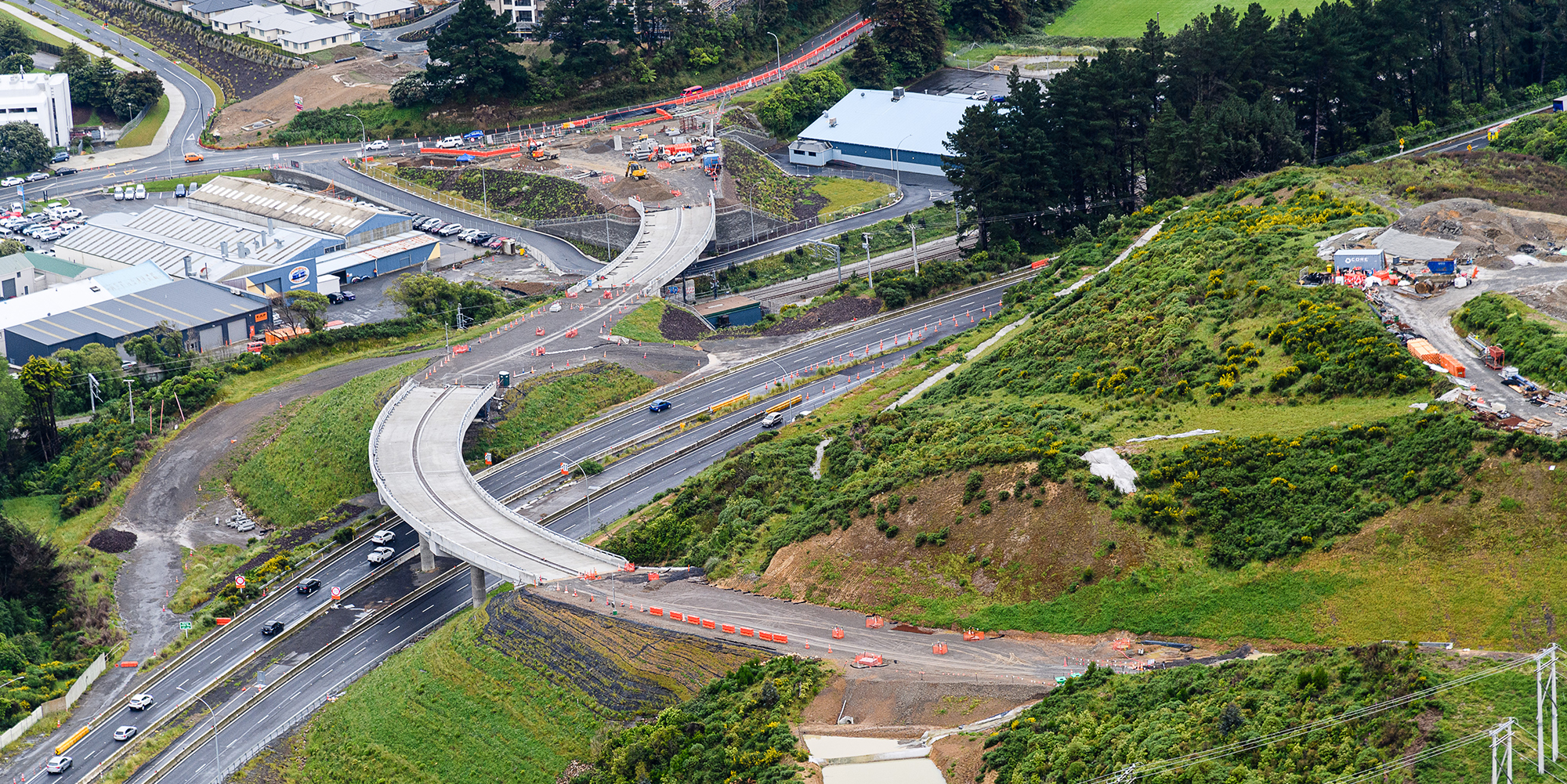
The Kenepuru interchange – December 2020.
With only ten months to go till opening, our team will be continuing to work hard behind the hills (except for statutory holidays), but we don’t expect there to be works that will cause disruption for motorists.
Over the Christmas and New Year holiday period, our maintenance team will be keeping an eye on our work sites on SH1 between Mackays crossing and Paekakariki and near Linden and on SH58 at Pāuatahanui.
Roadworks near Whareroa farm at Mackays Crossing will continue until 23 December and resume in early to mid-January. The week before Christmas is an opportunity for the team to complete any tidy up required before that area is closed down.
Roundabout works on Kenepuru Drive will begin in earnest in January. The roundabout will connect the new Transmission Gully interchange link road (which bridges the existing SH1, the North Island main trunk railway line, and Porirua Stream) with Kenepuru Drive.
After a wet, wild and frankly dismal November, we are all looking forward to enjoying summer temperatures, which are predicted to be warmer than average around the country, even in the capital. Good paving weather! But in the event of any large rainfall events, we will have a crew ready to respond to any incidents.
We continue to remind all members of the public to stay safe and not enter the project site at any time. Work is underway in multiple areas and it remains a high hazard area.
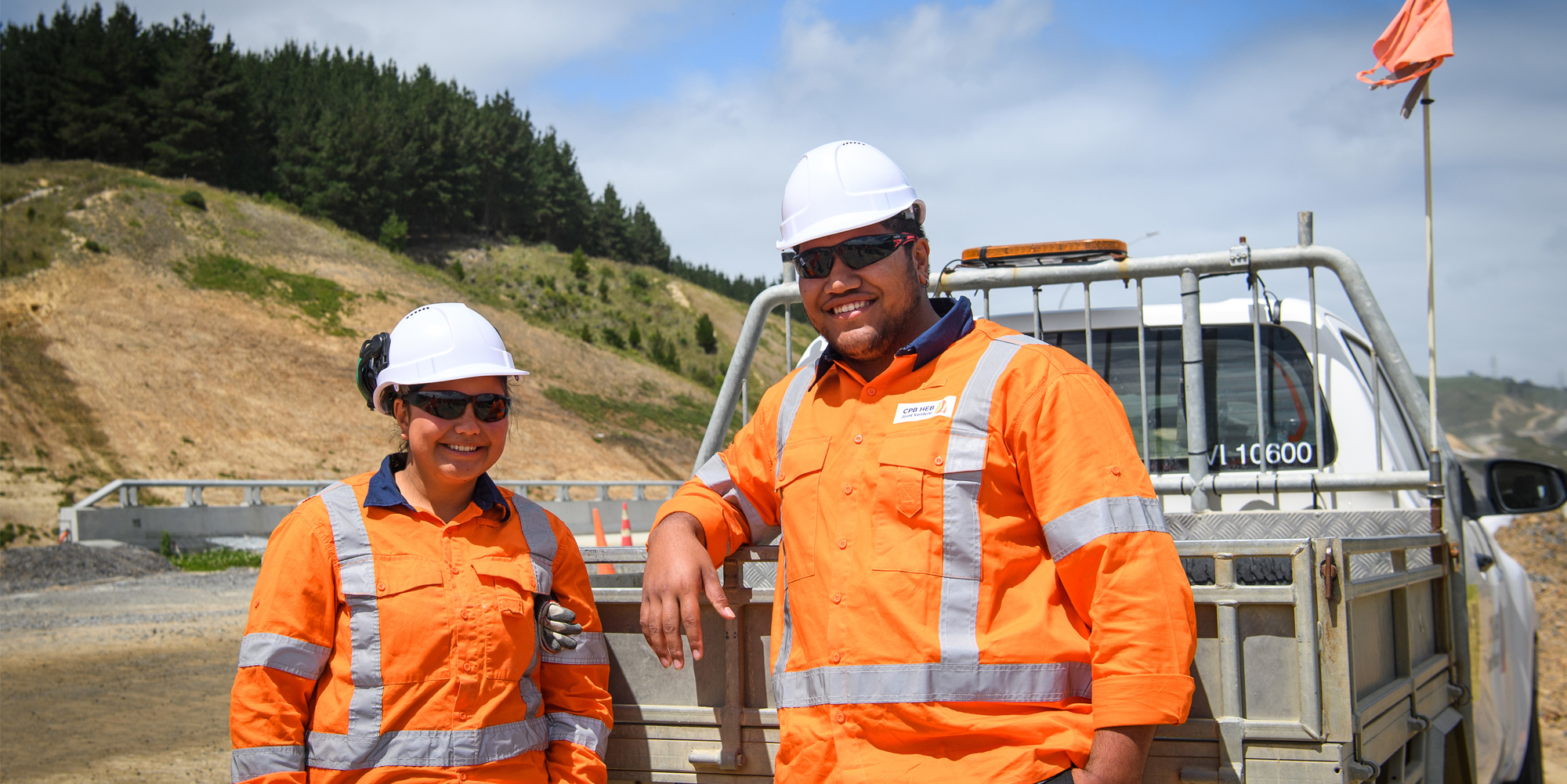
Two of our stores/plant team members, Hine Sollitt-Mackey and Fruen Samoa who helped us host Ngāti Toa on a recent site tour.
If you have any questions, please contact us at info@tg.co.nz. If you have an urgent matter, please call the 24-hour project hotline on 0800 TGINFO. If we are working outside of our normal work hours and you’re one of our neighbours, we’ll be in touch with you directly as usual.
Did you know that the Transmission Gully project is planting nearly 2.5 million native trees and plants, creating one of the most significant lowland native bush areas in the region? We’ll have more about that in our first newsletter next year. But for now,
Meri Kirihimete me te Hape Nū Ia, Merry Christmas and Happy New Year, from all of us on the Transmission Gully project.
Don’t forget to tell your friends and family to sign up to receive the latest project news.
Subscribe to email updates(external link)
We hope you enjoy reading these updates, and we’d love to hear from you. If you have any questions, comments or story suggestions, you can email them to info@tg.co.nz
For the latest traffic updates follow us on Twitter and Facebook: